
Wild Swimming’s “Death” Has Been Greatly Exaggerated: There’s Actually Important Momentum
From Paris planning open-air swimming in the Seine for its 2024 Olympics (and for the people in 2025) to more global travel destinations offering safe, social programs
Snapshot: A trend so hyped that it inevitably saw a recent backlash, wild swimming is actually seeing recent meaningful moves to make it safer and more accessible—from more countries and cities cleaning up waterways to create wild swimming sites, to more hotels and resorts offering wild swimming experiences, to the rise of wild swimming pools.
Our 2023 trend “Wellness + Water: Blue, Hot and Wild,” by Jane Kitchen, looks at the surge in people taking to the world’s natural waters, including the explosion in hot springs developments and wild swimming, and even the nascent trend of cross-country swimming. Wild swimming in natural lakes, rivers and waterfalls has been a major trend since the pandemic, certainly strongest in the UK, but now everywhere, even in congested Beijing. The number of wild swimming groups around the world has exploded (such as the Bluetits Chill Swimmers with over 100,000 members), offering social, safer group swims.
With so many Instagram posts, and so many articles on the endless benefits of wild swimming, it’s not surprising that the media tide has recently turned.
There has been recent important attention to the realities of sewage pollution risks (as in the UK) and warnings about rare pulmonary responses to extreme, icy water. The backlash can be so vocal that a columnist in The Guardian recently declared: “RIP, Wild Swimming!” But for every hater there’s a lover, such as a journalist in the Financial Times recently chronicling what ice swimming has done for her health and sanity.
Beyond the current polemics, below we look at some interesting forward thrust for wild swimming. As the leader of the project to create two new wild swimming ponds in East London (more below) put it, “There’s a real desire to swim in open water and reconnect with nature, but there just isn’t enough capacity at the moment to respond to that desire.”
Wild swimming moves in cities (get ready to take a dip in Paris!): The trend of wild swimming, and another one of our 2023 trends, the impact of wellness on urban infrastructure, are flowing together. Major news in April from Paris: The Summer Olympics are headed there in 2024, which will feature outdoor swimming races on the Seine. The river will also be the centerpiece of the city’s unprecedented opening ceremony, which won’t take place in a stadium, but along its banks. So, Paris is spending $1.5 billion to clean up the “world’s most romantic river.” The New York Times just detailed how complex this engineering project (the “Swimming Plan”) is, involving a maze of new underground pipes, tanks and pumps to prevent damaging bacteria from flowing into the Seine. Paris’s mayor, Anne Hidalgo, says that the city will then open 23 wild swimming areas on the Seine starting in summer 2025. As more cities experience heat waves, the Paris Experiment will likely inspire other cities to reclaim their waterways for wild swimming. As the scientist who tracks the Seine’s water quality put it: “It will create waves, so to speak, across the world because a lot of cities are watching Paris…It’s the beginning of a movement…”
There are many new examples of cities creating new wild swimming spots and beaches. In East London, open water swimming will return to the Canary Wharf business district this summer. Wild swimming sites have also hit Hackney and Lewisham, while Bristol has just created a wild swimming watercourse. This summer Manhattan gets its first public beach, Gansevoort Peninsula, featuring a big stretch of sand and a 5-acre park, where you can’t (yet) swim, but you can kayak. And a second beach, Domino Park in Brooklyn, will open by 2028, where, for now, the plans are limited to wading, but with a goal of full-fledged swimming.
Governments are doing more to clean up their waterways. For example, the UK, which keeps adding wild swimming sites (they’ve reached a historic 424), has just released their Plan for Water, setting out their action plan to clean up UK waters and ensure a plentiful future supply.
More hotel and resorts dive in: Travel Weekly recently covered how wild swimming has struck such a chord, that people are willing to travel far for it. There are many new examples of hotels and resorts creating new, safe guided wild swimming group offerings in nearby lakes, rivers and waterfalls, often creatively combining it with other wellness experiences. At Mohonk Mountain House in upstate New York, their Lakeside Immersion program begins with a wild swim in Lake Mohonk, using singing as breathwork, followed by yoga stretches and warm ginger inhalation therapy at the spa. Switzerland’s Le Grand Bellevue hosts a “wild wellness experience” in the Alps combining wild swimming, cycling tours, trail running, massage, foraging, cooking classes and mountaintop yoga.
Creating the “wild swimming effect”—from wild pools to pools set atop natural waterways: Outdoor pools have long been concrete jungles, but resorts are starting to experiment with wild pools that mimic the biophilic look, and natural living filtration system of ponds, using specific plants to absorb nutrients and clean the water. It’s an environmentally friendly alternative, with no or little chlorine needed. UK’s South Lodge and the Lurzerhof Hotel in Austria now feature wild swimming pools, and the just-opened Bracken Hide Hotel on the Isle of Skye features a “Wild Plunge Pool.” There are more urban lidos and swimming pools set right upon natural waterways: For instance, the Blue Mind Barge, opening on London’s Thames river in 2024, includes a big outdoor natural pool, a panoramic glass sauna, a cold plunge pool and hot bathing experiences.
Wild swimming’s death has been greatly exaggerated. The future: cleaning up waterways, cities creating more wild swimming sites, and travel destinations getting creative with structured wild swimming programs.
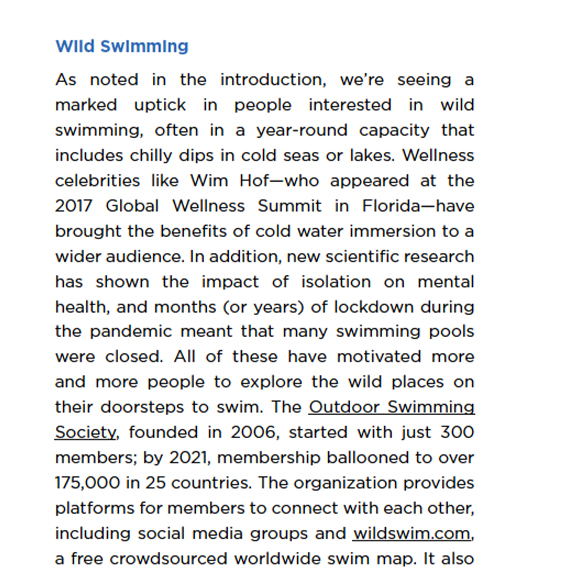
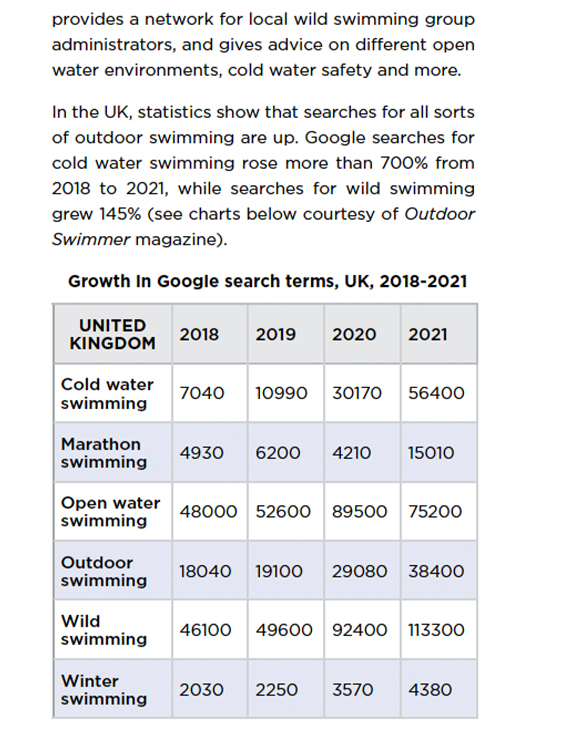
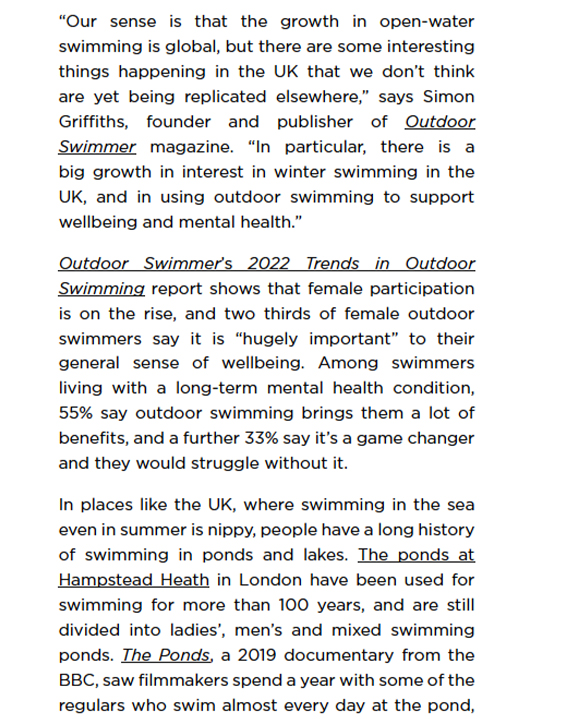
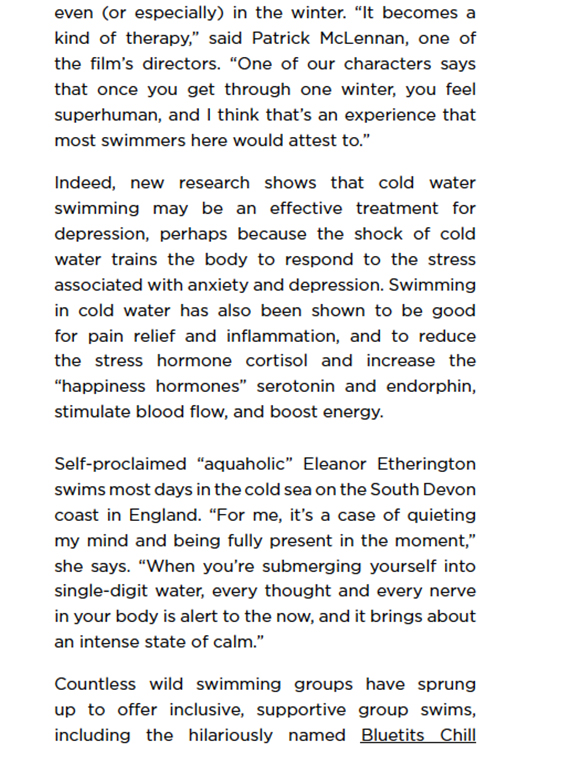
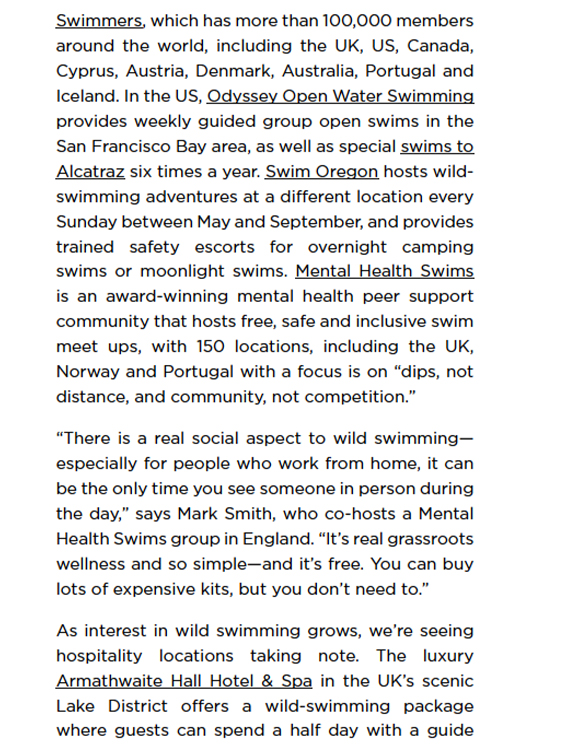
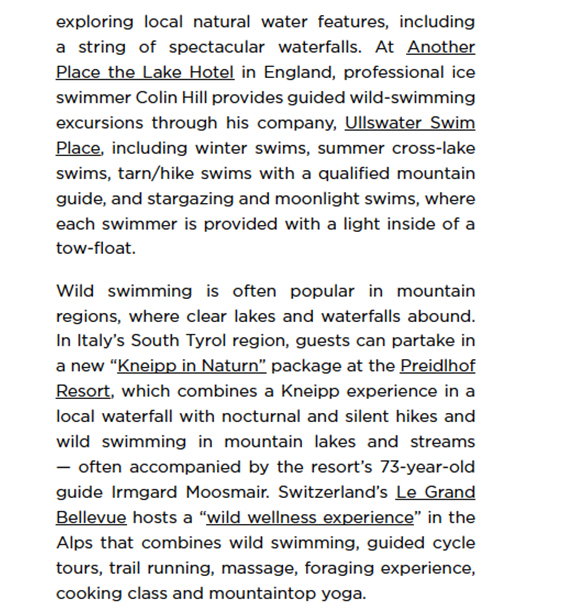
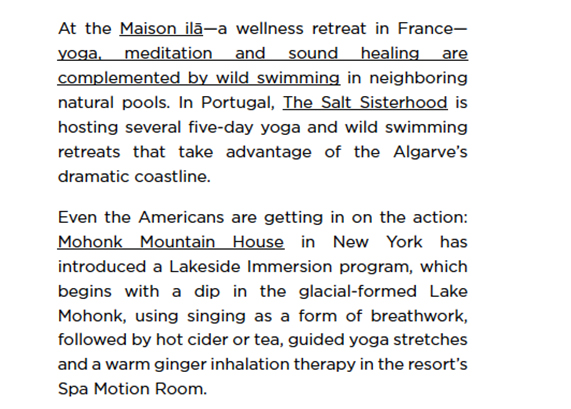
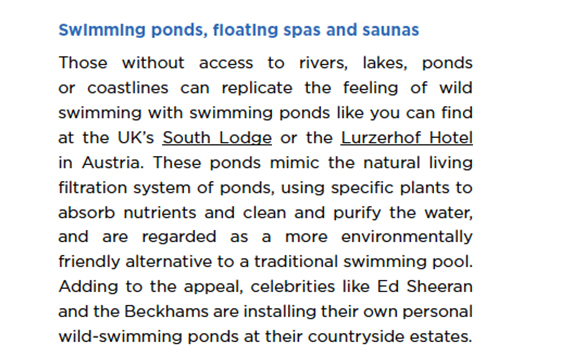
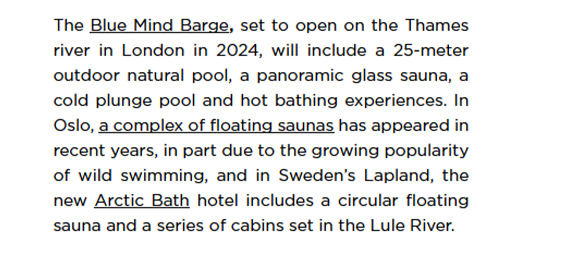
Buy the full “Future of Wellness: 2023 Trends” report, a 160-page analysis of what’s ahead for the business of wellness.
The TRENDIUM is a compendium of the latest trends impacting the
multi-trillion dollar global wellness economy.
Sign-up for monthly TRENDIUM emails.
